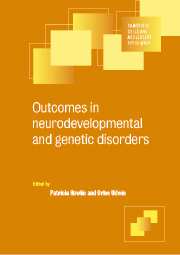Book contents
- Frontmatter
- Contents
- List of contributors
- Preface
- 1 Attention deficit hyperactivity disorder
- 2 Developmental language disorders
- 3 Reading and other specific learning difficulties
- 4 Metabolic disorders
- 5 Hemiplegic cerebral palsy
- 6 Autistic disorders
- 7 Down syndrome
- 8 Fragile X syndrome
- 9 Prader-Willi and Angelman syndromes: from childhood to adult life
- 10 Rett disorder
- 11 Tuberous sclerosis
- 12 Williams and Smith-Magenis syndromes
- Index
5 - Hemiplegic cerebral palsy
Published online by Cambridge University Press: 13 August 2009
- Frontmatter
- Contents
- List of contributors
- Preface
- 1 Attention deficit hyperactivity disorder
- 2 Developmental language disorders
- 3 Reading and other specific learning difficulties
- 4 Metabolic disorders
- 5 Hemiplegic cerebral palsy
- 6 Autistic disorders
- 7 Down syndrome
- 8 Fragile X syndrome
- 9 Prader-Willi and Angelman syndromes: from childhood to adult life
- 10 Rett disorder
- 11 Tuberous sclerosis
- 12 Williams and Smith-Magenis syndromes
- Index
Summary
Introduction
Cerebral palsy (CP) is the single largest cause of severe physical disability in childhood. CP is not a single condition but an ‘umbrella term’ for a heterogeneous group of congenital and early-acquired brain disorders that meet three criteria. Firstly, the disorders are long-lasting rather than short-lived. While most types of CP are life-long, some children with mild CP in early childhood do eventually outgrow their symptoms. Secondly, the underlying brain lesions are static, though the clinical manifestations may change as the child grows up. This criterion rules out progressive neurodegenerative conditions or brain tumours. Thirdly, the clinical manifestations include impairments of motor function, including weakness, stiffness, poor co-ordination or involuntary movements. These motor problems are often accompanied by other clinical manifestations of brain disorders, including epilepsy, learning problems and sensory impairments. The American term ‘static encephalopathy’ is roughly equivalent to CP, except that motor involvement is not obligatory.
The subclassification of CP is based on the type and distribution of motor problems. Spasticity – involving stiffness and weakness of affected muscles – is usually the dominant motor problem. This spasticity affects: just one side of the body in hemiplegic CP; both legs to a severe extent and both arms to a mild extent in diplegic CP; and all four limbs severely in quadriplegic CP (which is also known as tetraplegia or double hemiplegia). Less commonly, the motor problems are dominated by ataxia (incoordination) or by dyskinesia (involuntary jerking or writhing movements).
Keywords
- Type
- Chapter
- Information
- Outcomes in Neurodevelopmental and Genetic Disorders , pp. 112 - 135Publisher: Cambridge University PressPrint publication year: 2002

